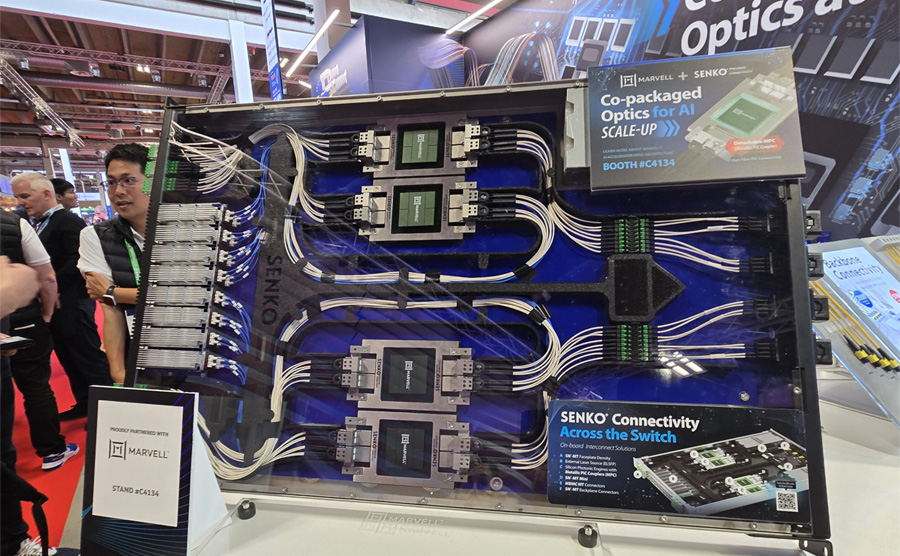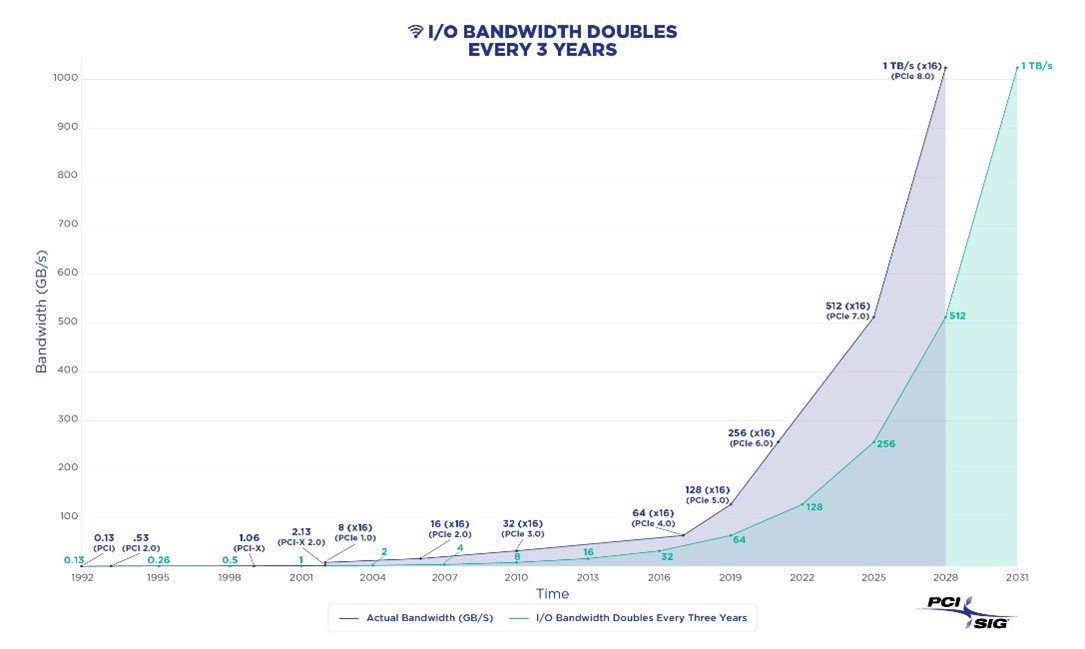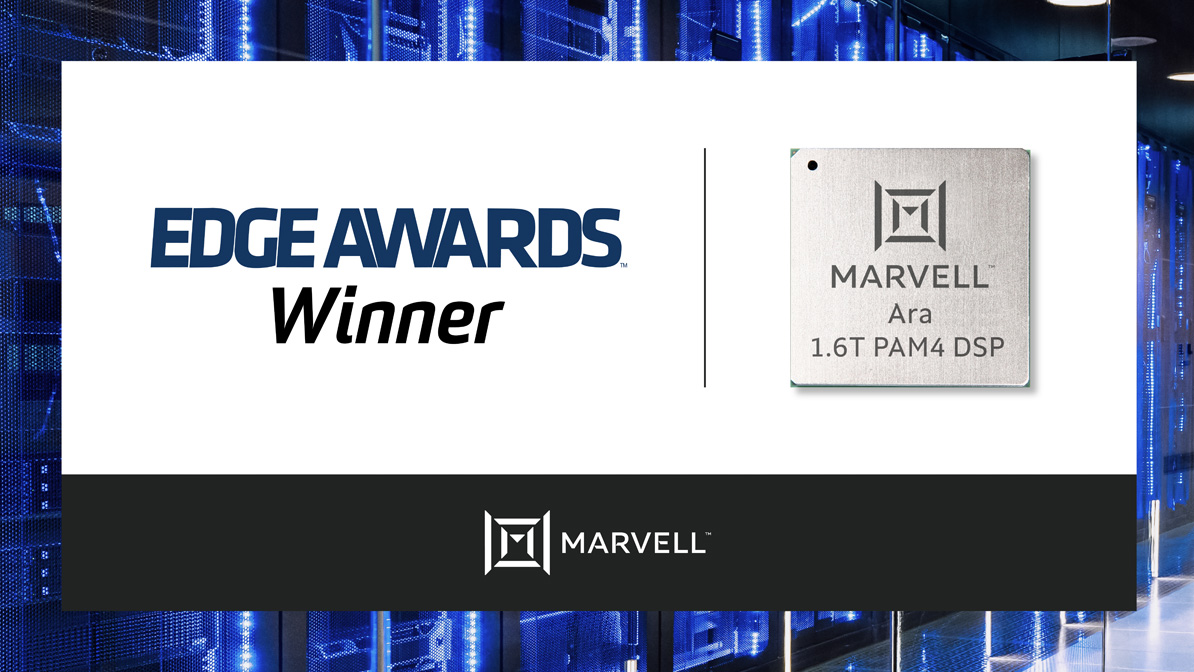

By Vienna Alexander, Marketing Content Professional, Marvell

Marvell was announced as the top Connectivity winner in the 2025 LEAP Awards for its 1.6 Tbps LPO Optical Chipset. The judges' remarks noted that “the value case writes itself—less power, reduced complexity but substantial bandwidth increase.” Marvell earned the gold spot, reaffirming the industry-leading connectivity portfolio it is continually building.
The LEAP (Leadership in Engineering Achievement Program) Awards recognize best-in-class product and component designs across 11 categories with the feedback of an independent judging panel of experts. These awards are published by Design World, the trade magazine that covers design engineering topics in detail.
This chipset, combining a 200G/lane TIA (transimpedance amplifier) and laser drivers, enables 800G and 1.6T linear-drive pluggable optics (LPO) modules. LPO modules offer longer reach than passive copper, at low power and low latency, and are designed for scale-up compute-fabric applications.
By Chris McCormick, Product Management Director, Cloud Platform Group, Marvell
Co-packaged optics (CPO) will play a fundamental role in improving the performance, efficiency, and capabilities of networks, especially the scale-up fabrics for AI systems.
Realizing these benefits will also require a fundamental transformation in the way computing and switching assets are designed and deployed in data centers. Marvell is partnering with equipment manufacturers, cable specialists, interconnect companies and others to ensure the infrastructure for delivering CPO will be ready when customers are ready to adopt it.
The Trends Driving CPO
AI’s insatiable appetite for bandwidth and the physical limitations of copper are driving demand for CPO. Network bandwidth doubles every two to three years, and the reach of copper reduces meaningfully as bandwidth increases. Meanwhile, data center operators are clamoring for better performance per watt and rack.
CPO ameliorates the problem by moving the conversion of electrical to optical from an external slot on the faceplate to a position as close to the ASIC as possible. This shortens the copper trace, which may improve the link budget enough to remove digital signal processor (DSP) or retimer functionality, thereby reducing the overall power per bit, a key metric in AI datacenter management. Achieving commercial viability and scalability, however, has taken years of R&D across the ecosystem, and the benefits will likely depend on the use cases and applications where CPO is deployed.
While analyst firms such as LightCounting predict that optical modules will continue to constitute the majority of optical links inside data centers through the decade,1 CPO will likely become a meaningful segment.
The CPO Server Tray
The image below shows a conceptualized AI compute tray with CPO developed with products from SENKO Advanced Components and Marvell. The design contains room for four XPUs and up to 102.4 Tbps of bandwidth delivered through 1024 optical fibers, all in a 1U tray. The density and reach enabled by CPO opens the door to scale-up domains far beyond what is possible with copper alone..

When asked at recent trade shows how many fibers the tray contained, most attendees guessed around 250 fibers. The actual number is 1,152 fibers.
By Winnie Wu, Senior Director Product Marketing at Marvell
Welcome to the beginning of row-scale computing.
At the 2025 OCP Global Summit, Marvell and Infraeo will showcase a breakthrough in high-speed interconnect technology — a 9-meter active electrical cable (AEC) capable of transmitting 800G across standard copper. The demonstration will take place in the Marvell booth #B1.
This latest innovation brings data center architecture one step closer to full row-scale AI system design, allowing copper connections that stretch across seven racks - that’s nearly the length of a standard 10-rack row. It builds on the prior achievement by Marvell of a 7-meter AEC demonstrated at OFC 2025, pushing high-speed copper technology even further beyond what was thought possible.
Pushing the Boundaries of Copper
Until now, copper connections in large-scale AI systems have been limited by reach. Traditional electrical cables lose signal quality as distance increases, restricting system architects to a few meters between servers or racks. The 9-meter AEC changes that equation.
By combining high-performance digital signal processing (DSP) with advanced noise reduction and signal integrity engineering, the new design extends copper’s effective range well beyond conventional limits, maintaining clean, low-latency data transfer over distances once thought achievable only with optical fiber.
By Annie Liao, Product Management Director, ODSP Marketing, Marvell
For over 20 years, PCIe, or Peripheral Component Interconnect Express, has been the dominant standard to connect processors, NICs, drives and other components within servers thanks to the low latency and high bandwidth of the protocol as well as the growing expertise around PCIe across the technology ecosystem. It will also play a leading role in defining the next generation of computing systems for AI through increases in performance and combining PCIe with optics.
Here’s why:
PCIe Transitions Are Accelerating
Seven years passed between the debut of PCIe Gen 3 (8 gigatransfers/second—GT/s) in 2010 and the release of PCIe Gen 4 (16 GT/sec) in 2017.1 Commercial adoption, meanwhile, took closer to a full decade2

Toward a terabit (per second): PCIe standards are being developed and adopted at a faster rate to keep up with the chip-to-chip interconnect speeds needed by system designers.
By Vienna Alexander, Marketing Content Professional, Marvell

Marvell is the Leading EDGE 2025 winner for its Ara product, a 3nm 1.6 Tbps PAM4 optical DSP platform, which enables the industry’s lowest power 1.6T optical modules. The engineering community voted to recognize the product as a leader in design innovation this year.
The EDGE awards celebrate outstanding innovations in product design for the engineering industry that have contributed to the advancement of technology. This award is presented by the Engineering Design & Automation Group, a subset of brands at Endeavor Business Media.
Ara is the industry’s first 3nm 1.6T PAM4 optical DSP platform. Marvell introduced it to meet growing interconnect bandwidth demands for AI and next-gen cloud data center scale-out networks.